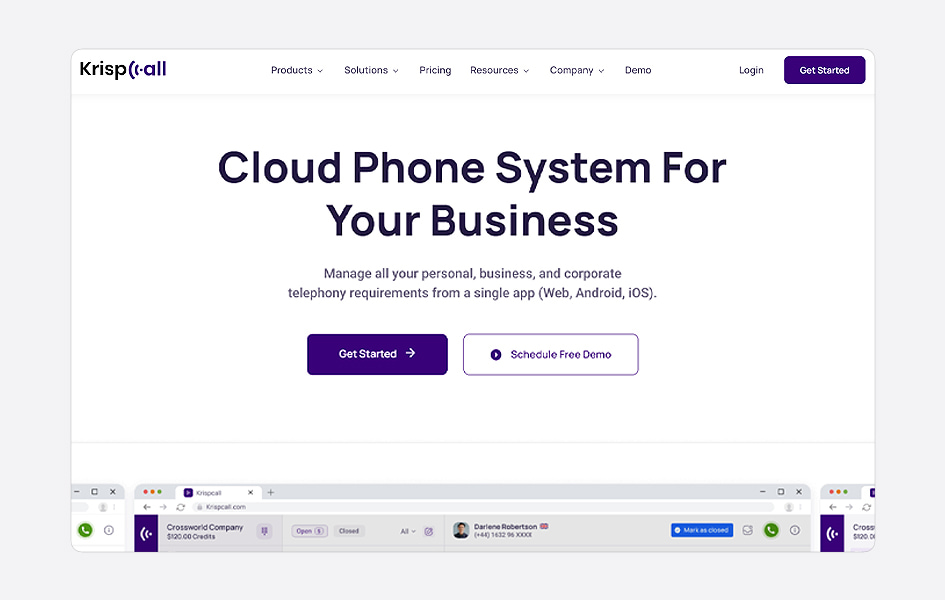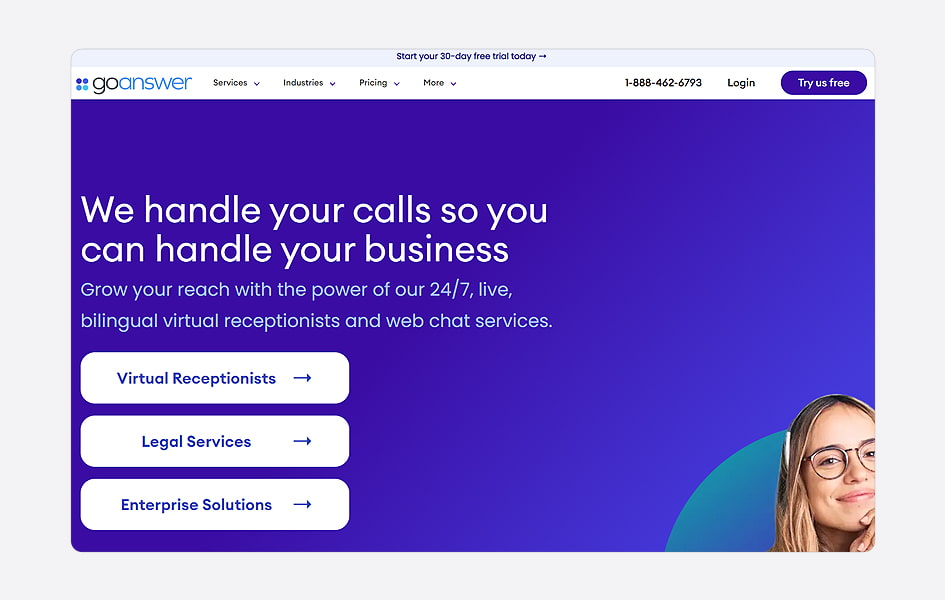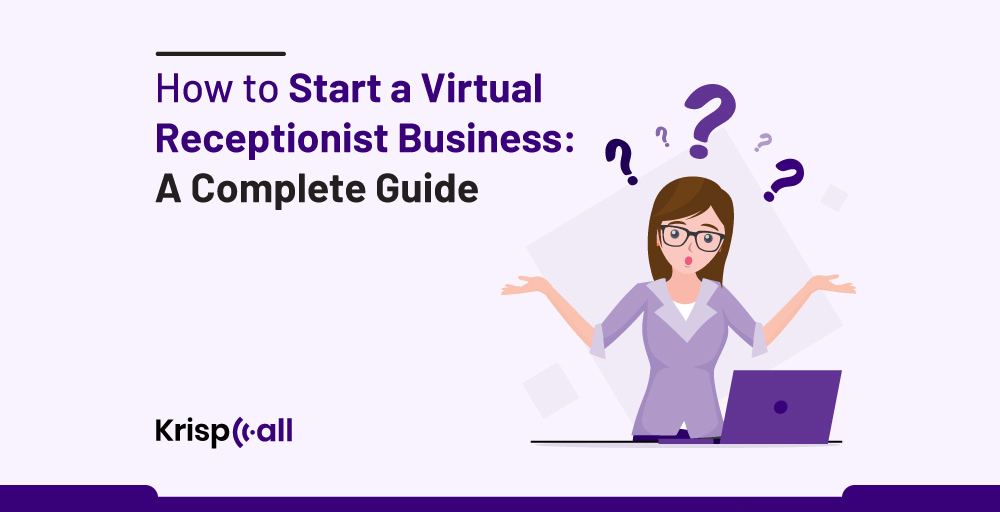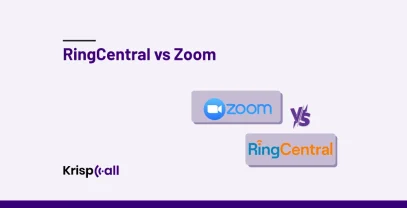Are you looking for a business opportunity that is both in demand and profitable and requires less budget and resources to start?
Then, Starting a virtual receptionist business may be the perfect fit for you.
The best part is that you can start your own virtual receptionist business from home with relatively low overhead. All you need is a computer, a phone, and a reliable internet connection.
Hiring virtual assistants through offshore agencies increased by 41% in 2020, according to the reports from Nanoglobal. And until 2023, the outsourcing virtual receptionist industry will have an estimated growth of 4.5%.
In this blog, you’ll learn how to start a virtual receptionist business from home step-by-step including choosing your services, setting prices, marketing business, finding clients, and many more.
What is Virtual Receptionist Business?
A virtual receptionist business is a company or an individual that provides a service to other businesses of all sizes, from administration to email management to answering telephone calls, without needing in-house staff.

A virtual receptionist (VA) can do anything that a traditional receptionist can do from a remote site. Virtual receptionist businesses offer different services, including:
- Directing calls: Virtual receptionists answer business calls and forward them to the appropriate team members.
- Managing social media: A virtual receptionist can post updates, respond to comments, schedule and post blog posts, market social media, and run social media contests on your behalf.
- Assists in tasks: A virtual receptionist can handle complex tasks such as qualifying leads and, scheduling appointments, increasing sales.
- Scheduling appointments: Virtual receptionists can schedule appointments for you with customers or clients.
Virtual Receptionist Vs. Personal Assistance Business: What is the Difference?
Virtual receptionists and personal assistants provide administration support to clients, but they differ in several ways.
| Virtual Receptionists Business | Personal Assistance Business |
| A virtual receptionist business offers phone answering and call handling services on behalf of the business. | A Personal Assistance business provides different administrative and personal services to the business or individuals. |
| Primary services include call forwarding, essential customer support, and appointment scheduling. | Main services include email, calendar management, personal shopping, event planning, and document preparation. |
| Sought by Businesses and Companies that need help managing their customer and call and may not require full-time service. | Demanded by busy professionals who require assistance full-time with a broad spectrum of tasks to increase their productivity. |
| Routing and handling of calls are largely Dependent on virtual call center software and phone systems. | Provides a wide range of tools and software, such as office suites, project management software, and communication networks. |
How Does Virtual Receptionist Business Make Revenue?
It is a straightforward process linking businesses with a network of virtual receptionists who are available on a flexible schedule to assist with customer and administrative services. Business owners can hire a virtual receptionist to provide remote receptionist services for their businesses.
First, let us explain how this revenue generation model works before diving into it.
How does the business model work?
The virtual receptionist business model works by providing businesses with a professional and efficient way to handle their incoming calls without having to hire a full-time in-house receptionist.
Virtual receptionists are trained professionals who work remotely to answer and direct calls for businesses of all sizes. These services are designed to handle communication-related tasks, primarily incoming calls and messages, on behalf of clients.
Here are the basic elements of the working of the virtual receptionist business model:
- Setup and Service Offering
- Client Acquisition
- Hiring and Training of agents
- The development of the Technology Infrastructure
- Quality Assurance and Data Security
- Customized Benefits for Clients
- Blended Business models
How is the revenue generated?
As we’ve gained a better understanding of the virtual business model, we now look at how it generates revenue. It includes a variety of methods, including:
- Fees for subscriptions: A virtual receptionist company charges a monthly fee for answering calls and providing other services based on the number of calls per minute used or simply with varying levels of services.
- Pay-per-minute: Pay-per-minute pricing is also offered by some virtual receptionist companies. A virtual receptionist only charges businesses for the minutes they spend answering calls. For businesses whose call volume fluctuates, this can be a good option.
- Per-lead fees: It is possible to pay per lead with some virtual receptionist companies. A virtual receptionist generates leads for businesses for a fee. Businesses looking for more sales leads may find this useful.
- Customization and Integration: Virtual receptionist solution providers may also charge their clients for customized scripts and integrations with a specified tool or for special training and support for their staff. This helps generate more revenue for the company.
- Additional services: Many virtual receptionist companies also offer additional services, such as appointment scheduling, customer support, and lead nurturing. Businesses can pay for these services on a monthly basis or on a per-user basis
How to Start a Virtual Receptionist Business in 2023?
Virtual assistants are an excellent option for those wishing to appear professional to clients. However, the process isn’t easy, and it requires planning and execution.
Here’s a step-by-step guide that helps you to start your own virtual reception business from home.
1. Assess Your Skills and Interests
Before you start a virtual receptionist business, you should assess your skills and interests. These are the common skills and qualities required to start a virtual assistant business.
- Communication skills: You should have strong writing and verbal communication skills for easy interaction with clients and someone in your business.
- Technology-savvy: You must be proficient in technology and should know how to use the virtual receptionist software and other communication tools.
- Time management: It is important for a virtual receptionist like you to manage multiple tasks and clients effectively within a limited timeframe.
- Trustworthiness: Virtual receptionists should handle their administrative duties efficiently. They should be alerted to potential costly errors.
- Adaptability: You must be flexible and be ready to adapt to the ever-changing needs of your clients based on their purpose and their industry.
- Customer service: Providing excellent customer service to your clients is the cornerstone of your work, so you must be mindful and try to give your clients what they want.
2: Market Research and Niche Selection
The next step is researching your target market based on your niche or specialization, which in turn is based on your skills and the market demand.
It’s essential that the selected niche aligns with your skills and prior experience, so research a niche that inspires you and provides motivation. Identify your strengths and weaknesses and pick a better industry to reduce competition and improve brand visibility quickly.
The best niches for virtual assistance are appointment scheduling, customer service, bilingual reception, and administrative services, which cater to clients’ specific needs.
These are the industry-specific niches you can choose to start your VA agency.
- Real Estate Virtual Assistance: Virtual assistants specialize in real estate and assign calls to the appropriate teams or agents according to the type of property or location. Virtual receptionists provide information on properties, tour schedules, and availability and offer real-time validation.
- Virtual assistance for construction companies: With virtual remote assistance, contractors can receive administrative and support services remotely. The software helps businesses streamline operations, reduce costs, and increase efficiency by assisting with tasks like project management, scheduling, document management, and client communication.
- Virtual Administrative Assistant: Virtual administrative assistants provide remote administrative support to individuals, businesses, and entrepreneurs. As part of their role, virtual assistant staffing handles emails, schedules appointments, organizes files, conducts research, and assists with various administrative duties.
- Virtual Data Entry Assistant: Businesses can use the virtual data entry assistant to automate tedious data entry tasks, freeing up valuable human resources and allowing them to focus on strategic and creative endeavors.
- Bookkeeping and Accounting Assistant: A virtual Bookkeeping assistant manages financial transactions, maintains accurate records, and ensures compliance with financial regulations. Businesses can handle their data efficiently and securely when tedious tasks are automated.
- Healthcare Virtual Assistance: Healthcare Virtual Assistance manages administrative tasks and interactions with patients using artificial intelligence, thus increasing efficiency, reducing administrative burdens, and improving patient satisfaction.
- Virtual Assistance for Insurance Agencies: Virtual assistance for insurance agencies is a game-changer in the industry. Embrace virtual assistance to enhance your agency’s efficiency and provide exceptional service to your clients through the use of this technology.
- E-Commerce Support Assistance: The enhanced virtual receptionist who specializes in the niche of E-commerce support should be able to help with tasks such as order processing, inventory management, and product listing. Additionally, for those aiming to specialize in administrative support for beauty and wellness industries, incorporating a salon booking software into your virtual receptionist offerings could elevate your service value. By facilitating seamless appointment scheduling and client management for salons, this specific tool could define a niche that directly caters to a bustling sector craving organizational efficiency.
- Virtual Assistance Services for Therapists: A virtual assistant offers administrative support, oversees your online presence, and handles customer service for your therapy practice. Almost anything your private practice requires can be handled by your virtual assistant, as long as the task is one they can perform remotely.
What are Some Virtual Receptionist Business Ideas?
When choosing a virtual receptionist business idea, it is important to consider your skills, experience, and interests. It is also important to identify a target market, determine what services they are most likely to need, and help them manage their tasks and responsibilities.
Here is a list of some personal assistance business ideas that you can go for:
- Social Media Manager
- Content Creator
- Virtual Assistant services
- Executive Assistant services
- Home organization services
- Data entry services
- Bookkeeping and Accounting Services
3: Create a Comprehensive Business Plan
Once you’ve decided on your services and niches, you must write a business plan. A well-thought-out business plan is essential for the success of your virtual receptionist business in any given environment.
This will help you to map out your business goals and strategies. Your business plan should include the following:
3.1 Description of Your Business and its Services
The first thing you need to do is to define the services you will offer as a virtual receptionist, such as answering calls, scheduling appointments, and providing customer support. Explain how your services will benefit your clients and what sets you apart from your competitors.
3.2 Your Target Market
Secondly, you must identify your target market, such as small businesses, entrepreneurs, or busy professionals. Get in touch with them by describing their needs and pain points and how your services can help solve their problems.
3.3 Your Competitive Advantage
Following that, explain what makes your virtual receptionist business unique and how you differentiate yourself from your competitors. Highlight your strengths, such as your experience, skills, or technology.
3.4 Your Marketing and Sales Strategies
The next step is to outline your marketing and sales strategies, such as social media marketing, email marketing, or networking. Describe how you will reach your target market and convert them into paying clients.
3.5 Your Financial Projections
After that, you need to create a financial plan that includes your startup costs, revenue projections, and expenses. You should estimate your pricing strategy and how many clients you need to break even to make a profit.
3.6 Resources and Tools You Need
As a virtual assistant service, it carries time-consuming tasks like order processing and live chat. To deal with it, be sure to check the very useful online courses, resources, and tools for creating a comprehensive business plan. You will need to acquire a VoIP phone system, a CRM system, and a project management service, and invest in virtual receptionist software.
For managing time and resolving customer queries, tools like time tracking, communication, project management, accounting tools, and more can become handy. Some prevalent tools are Time Doctor, Hootsuite, Wave, Google Calendar, Dropbox Business, and Skype.
3.7 Virtual Reception Staffing Projections
Lastly, based on the above-mentioned strategies, you can estimate how many virtual receptionists/agents you need to hire to meet the demand for your services. You can make this decision based on considerable factors such as workload, availability, and skill level.
4. Legal and Administrative Considerations
Before you start your business, you need to make sure that you’re following all of the applicable laws and regulations. This may include registering your business with the state and obtaining the necessary business licenses and permits.
Below are ways to address these factors.
- Legal Aspects: Employ sole proprietorships, LLCs, and corporations to manage liability and taxes and consult with professionals for advice. Comply with local regulations and make sure that all permits are obtained. For example, you will need to personalize LLC operating agreement documentation if this is the structure you select for your virtual receptionist business, since all those involved have to be committed to the same legal obligations as one another, and adhere to relevant rules for this type of commercial organization.
- Tax Considerations and Financial Planning: Utilize financial records and seek professional advice if you are still determining the tax implications of your business structure. Identify revenue sources and expenses, as well as technology costs.
- Legal and Financial Advisors: Consult a business attorney for contracts, compliance, and data protection. Just contact small business or virtual services experts for advice and support. Reach out to your local Small Business Development Centers and Small Business Administration.
What Contacts, Agreements, and Policies will I need?
For establishing a virtual receptionist business with the following contracts and documents:
- Business Formation Documents: Articles of incorporation or organization, depending on your business structure.
- Licenses and Permits: Business licenses and any relevant permits from local authorities.
- Insurance Policies: Liability insurance and errors & omissions (E&O) insurance.
- Privacy Policy: A document explaining how customer data is collected, stored, and used, ensuring compliance with data protection laws.
- Terms and Conditions: A document outlining service terms, including payment terms, termination, and dispute resolution.
- Employee/Contractor Agreements: Contracts for virtual receptionists specifying roles, responsibilities, and confidentiality agreements.
- Non-Disclosure Virtual Assistance Contracts(NDAs): Agreements to protect sensitive client information.
- Payment and Billing Policies: Details on invoicing, payment methods, late fees, and refund procedures.
- Website Terms of Use: Terms of use for your website covering user behavior and liability.
- Marketing and Advertising Policies: Guidelines to ensure truthful and compliant marketing practices.
- Tax and Financial Reporting Documents: Tax-related documents, financial reports, and compliance with tax laws.
5: Setting Up Your Virtual Receptionist Business
Once you are done with the legality, it’s time for you to actually set up your virtual receptionist business, and setting up a virtual assistant business can be flexible and fulfilling.
To set up your virtual receptionist business, you can take the below-mentioned factors into consideration
- Efficient Home Office: Make sure your workspace is quiet and dedicated. Make sure you invest in ergonomic furniture and good lighting. Keep your workspace organized and personalized.
- Necessary Equipment and Software: Install a high-speed internet connection and a reliable computer. Set up a phone system (VoIP or dedicated) and use virtual receptionist software. Use scheduling software and CRM software for efficiency.
- Time Management and Productivity: Set consistent work hours and communicate them. Utilize management tools to prioritize tasks. Automate processes by using time blocking. Minimize distractions and stay focused.
6: Branding and Marketing Your Service
After setting up your business, the next step is to make your business a brand and then start marketing your services. Following these steps will help you market your virtual receptionist business effectively, attracting clients and fostering long-term success.
For your virtual assistant branding, carefully focus on these key points:
- Develop a strong Brand Identity: Firstly, you need to build your business’s brand identity. This includes the creation of a consistent and eye-catching business name, logo, tagline, and overall appearance.
- Professional Online Presence: The next step is to polish your online image to boost credibility and trust with a professional-looking website. Industries that need virtual assistance can show that their business is legitimate attention when they land the page without the need to cost a lot.
- Business Website: Make your website easy to use and informative. Your brand is your organization’s first impression and does not have to be complicated. It should contain information about your services, pricing, and a portfolio that will appeal to clients.
- Use Social Media: Your target audience should be catered to on the right platforms. Thus, it’s encouraged to establish a consistent brand and engage your audience.
- Professional portfolio online: Following that displays your skills and achievements by using before-and-after pictures, testimonials, and case studies.
- Tips for marketing and branding: Identify your brand and make it stand out. Create valuable content to inform your decisions and run your business ads using online advertising platforms like Google and Facebook. Tailor your efforts to the needs of your ideal clients.
- Get testimonials from satisfied customers: The last step is to collect testimonials from your satisfied customers and put them on display on your business’s website and social media pages.
7: Finding Clients
After setting up your virtual receptionist business, finding clients is the next step. To establish credibility with potential clients, you should build a client portfolio to showcase your experience. To help you with that, here are some strategies for finding clients:
- Various freelance platforms and job boards: Register on platforms like Upwork and Fiverr and apply to relevant job postings regularly.
- Make Connections: Participate in online events, use LinkedIn, and connect with industry professionals.
- Recommendations: Consider offering referral bonuses to existing clients and contacts.
- Build Online Presence: Develop a professional website and optimize it for search engines. Spread the word about your business on social media.
- Cold Outreach: Identify potential clients and reach out directly to them.
- Online Advertising: Use platforms such as Google Ads and Facebook Ads to advertise online.
- Join Associations: Attend events organized by professional associations and chambers.
8. Pricing Your Services
Most VAs often have difficulty determining what their starting rate should be. If your goal is to make money as a virtual assistant, you should evaluate your skills and experience.
It’s suitable to do extensive market research on pricing models and calculate profitable rates. To make it easier for you, here are some essential factors to be considered;
8.1 Cost Analysis
To begin, calculate your variable and fixed costs. These may include factors like Software and Technology expenses, Taxes and fees, Agent salaries and payments, and marketing and advertising costs.
8.2 Understanding Target Rates
The second factor is to understand how other providers have priced their services. You should thoroughly research the plans and pricing of every provider in the targeted industry and then put forth competitive rates for your services.
8.3 Determining Profit Margin
Having analyzed the market and standard pricing, the next step is to decide on a reasonable profit margin that is sustainable enough for your business’s future growth.
8.4 Defining Service Packages
The next step is to create different packages or tiers with variable features for specific client needs. Some examples are basic, standard, premium, and customs, with increasing prices and features offered, respectively.
8.5 Pricing Models
Finally, the last stage is to create pricing models that align with your business strategies. You can build your pricing models in the following examples:
- Monthly Packaged Subscription
- Pay-Per-Call/Task
- Project-based Pricing
- Hourly Rates
9. Managing Client Relationships
In order to manage client relationships successfully, you need to master these aspects. Managing these aspects will help you build strong relationships with clients and ensure the success of your virtual receptionist business.
- Effective Communication: Make sure you communicate clearly and promptly, listen actively, and set realistic expectations. Keep your audience updated regularly and welcome feedback.
- Task and Deadline Management: Prioritize tasks and set realistic deadlines. Use time tracking and delegation efficiently. Follow up with clients regularly.
- Addressing Challenges: Develop written instructions to prevent miscommunication. Define project scopes and handle changes professionally. Handle missed deadlines and challenge clients with firmness. Use contracts for protection and maintain work-life balance.
10. Scaling Your Business
Implement these steps to ensure your business’s growth, financial health, and tax compliance.
To scale your virtual receptionist business:
- Growth Strategies: You need a sample virtual assistance business plan if you want to start or expand a virtual assistant business. Once you get the idea to scale the business, you can focus on client retention and online presence.
- Hiring Assistance: Consider subcontractors or assistants for workload relief. Have improved organizational skills and demonstrable experience with administrative duties like reporting to senior-level management.
- Managing Workload: Prioritize tasks and use efficient tools. Without scaling your staff, it’s not possible for your business to grow.
- Finances and Taxes: Separate personal and business finances. Keep meticulous records and comply with tax regulations. Use accounting software or professionals for complex finances.
Top 5 Virtual Receptionist Software Providers in 2023
Below, we listed some of the best virtual receptionist software providers doing well in different industries, offering affordable and excellent VoIP services.
1. KrispCall
The virtual receptionist software offered by KrispCall is renowned for its adaptability and seamless integration with popular apps, as well as its features, such as automated answering, live call routing, unified call box, call recording, and call analytics.

Its software is user-friendly and doesn’t require technical expertise. With virtual numbers, call center solutions, and virtual receptionist capabilities all under one roof, Krispcall is the ultimate partner for businesses seeking to thrive in the digital age.
KrispCall targets to provide secured and affordable virtual receptionist software with end-to-end encryption so the conversation remains safe and private. KrispCall has services to fit every business, regardless of size or budget.
Pros:
- Affordable pricing
- Offer phone numbers in over 100 countries.
- Highly customizable and scalable
- Good customer support
Cons:
- No call Barging (Coming soon).
- The API widget is currently unavailable (coming soon)
Features:
- Call Recording
- Call Monitoring
- Voicemail
- Call Analytics and more.
2. AnswerConnect
AnswerConnect is known for providing excellent customer service and high-quality agent support. Their features mainly include call forwarding and voicemail transcription, which makes it favorable for every business.

Pros:
- Provide shared numbers
- Texting automation to save time
Cons:
- No two-factor authentication
- Low call quality
- Sometimes, calls automatically disconnect
Features:
- Live chat support
- Appointment Scheduling
- Live Call Answering
- Connect via Teleport Video
3. Nexa
Nexa is another good example that can help in enhancing call-handling facilities. The company provides virtual receptionists to answer questions, address product concerns, schedule appointments, and more 24 hours a day, seven days a week.

Pros:
- Seamless CRM Integration.
- Outbound Sales & Calling Campaigns
- 24/7/365 Live Call Center
Cons:
- No omnichannel support
- Latency and call lagging
Features:
- Appointment Scheduling
- Inbound and Outbound Sales
- 24/7 Answering Services
- Overflow and After hours Call support
4. Ruby Receptionist
Ruby Receptionist is another virtual receptionist provider that gives an affordable rate. They offer Virtual Assistance Services for Small Businesses and provide insights to capture more opportunities by leveraging their personalized insights.

Pros:
- No contracts, no hidden fees.
- No language barriers
- Dynamic software integration
Cons:
- Isn’t equipped with customized conference call greeting messages
- Incompatible with Linux
Features:
- Multichannel customer support
- 24/7 Coverage
- Dynamic Integrations
- Chat-call connection
5. Go Answer
It is a well-established company that offers customized services and automated receptionists and is becoming increasingly popular. With solutions that let people reach you wherever and whenever they want, you can meet people’s rising expectations.

Pros:
- Delivers Enhanced Security
- Number Sharing
- Real-time reporting and Monitoring
Cons:
- Steep Learning Curve
- Lengthy setup time
Features:
- Web Chat
- Custom Scripts and Workflows
- Dedicated agents
- Custom software integrations
What technology trends in virtual receptionist services should I be aware of?
AI has revolutionized virtual receptionist services by improving their capabilities, efficiency, and personalization. Businesses that leverage these technology trends can provide better customer service, reduce costs, and gain a competitive edge in today’s digital landscape.
Here are the trends in virtual receptionist services you should be aware of:
- Remote Reception Software: The use of remote reception software, including anyDesk and TeamViewer, is making a difference in business. The technologies bring effective solutions the virtual assistant needs to streamline communications.
- Emotional Intelligence: The technology trend in virtual receptionist services to watch out for includes the tracking of caller emotions and sentiments. VA will use data of emotional intelligence to better understand and connect with its customers.
- Natural Language Processing: NLP is the way voice assistants reply and get to know human speech. This lets virtual receptionists improve human interaction through its chatbots that understand the intent of customers.
- Social Media Channels: The demand for social media is growing, and another innovative trend is optimizing a social media profile to generate leads and sales conversions. Users are more likely to take notice of a virtual receptionist if the online traffic source is dominant.
- Utilize digital tools: The use of digital tools helps virtual receptionists to personalize customer interactions, manage business operations, and reduce paperwork. Relying on the right tools leads to a more tailored and engaging experience.
Conclusion
In summary, the right receptionist software can be a great benefit for businesses of all sizes and budgets. With a virtual receptionist, you can provide 24/7 customer service, answer incoming calls, and provide a personalized experience for your customers.
For businesses that need assistance, the virtual receptionist can be a game changer, and choosing the right Virtual Assistant can improve the efficiency and productivity of their clients. This process is done by utilizing digital resources, tools, and effective communication skills, allowing clients to concentrate on their core business activities.
If you are looking for a virtual receptionist software provider, our recommendation is KrispCall. KrispCall’s advanced cloud telephony software delivers exceptional customer service without hiring an in-house receptionist. It is known for dramatically decreasing the chances of missing important messages.
FAQ
What are the requirements to start a Virtual Assistants Agency?
The requirements for Virtual Assistants for starting a VA Agency are:
- Necessary Skills and Experience
- A well-developed business plan
- Investing in the right technological tools
- Marketing your agency
- Delivering excellent customer service
What are the advantages of starting a virtual assistant business?
There are many advantages to starting a virtual assistant business. Some of them are:
- Better Cost and Time savings
- Increased Flexibility and Productivity
- Desired Scalability and Freedom
- Improved Client Relationship
- Reduced burden on Administrative Operations
What Are the Steps to Becoming a Remote Virtual Assistant?
Follow these steps to become a remote virtual assistant.
- Decide on a business name.
- Identify the services you will offer as a virtual assistant.
- Prepare a price list and package your services.
- Take care of your insurance needs by securing a contract for you.
- Create your invoicing system.
- Make sure your business is branded.
- Make yourself known as a virtual assistant.





